The Bucephalandra is a relatively new plant in the aquarium world. It’s a low light plant and is very easy to care for. There are quite a few types of bucephalandra such as the bucephalandra red mini among others, each with their own unique color, size and shape. There are more than 30 species of buce plant, another name (easier to pronounce name) for the bucephalandra.
The Bucephalandra is part of Araceae which is a family of monocotyledonous flowering plants. They are indigenous to more tropical waters and found in rivers and streams of Borneo. Their root systems are strong and have developed over time to resist the fast-flowing waters. They lock themselves tightly into the hardscape and have become a very resilient species.
| Information Chart | Bucephalandra |
|---|---|
| Scientific Name: | Microcasia Becc Bucephalandra |
| Family: | Araceae |
| Care Level: | Easy |
| Growth Rate: | Slow |
| Maximum Size: | 10 inches |
| Minimum Tank Size: | 5 gallons |
| Water Conditions: | pH 6-7.5 |
| Temperature: | 71-82.5 °F (21.5-28 °C) |
| Lighting: | Low to medium |
| Propagation: | By rhizomes |
| Placement: | On hard substrate in low lighting |
Table of Contents
Bucephalandra Appearance
As said, these aquarium plants come in many species each with their own coloring, size and shape . They are quite diverse and can grow in and out of water. They are very exotic-looking with bluish-green leaves and undersides with white, red or yellow spots. Buce plants have far-reaching roots that seem to take over the bottom of the aquarium and at full size, they grow to be about 10 inches or so.
However, it’s worth it to note that the bucephalandra is a very very slow growing plant, so reaching the maximum size of 10 inches could take a while. The bucephalandra is not only known as one of the most beautiful aquatic plants because of their leaves, but also their flowers as well. From time to time, the bucephalandra blooms little white or pink flowers.
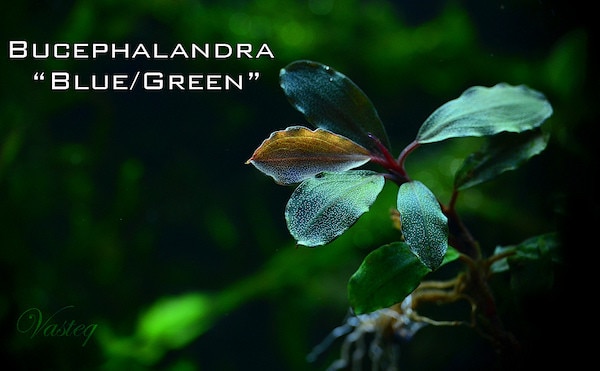
Most species of the bucephalandra have green leaves, although some have other coloration mixed in. Depending on the type you buy, many species of this plant are not very brightly colored. Usually, the newer leaves emerge with bright coloration but begin to fade as the leaves age. A trick to make sure it seems like the leaves are always vivid is to grow them in clumps.
To do this, you need sufficient nutrients, lighting and CO2. What’s amazing about the color of these plants is they appear to be iridescent. This means they sort of shimmer and reflect colors of the rainbow at different angles.
They can be emersed or submersed and can switch between the two all year round. The difference mainly between the two is that submersed plants tend to be brighter in color.
Some of the recognized types of bucephalandra include: Brownie Brown, Wavy Green, Titan, Godzilla, Hades, Theia green, Deep blue, Red min, Velvet, Dark wave, Brownie Purple, Super Blue, and Brownie firebird.
Bucephalandra Natural Habitat
The bucephalandra is a hardy plant that is easy to care for because they can tolerate extreme climates. This is why they are a wonderful plant to keep in your aquarium. However, they are mostly found in tropical waters in rainforests near Borneo. Where is Buce plant located? They are mostly found in streams and rivers around Indonesia.
Bucephalandra: Care and Tank Set-Up
Bucephalandra Tank Size and Specifications
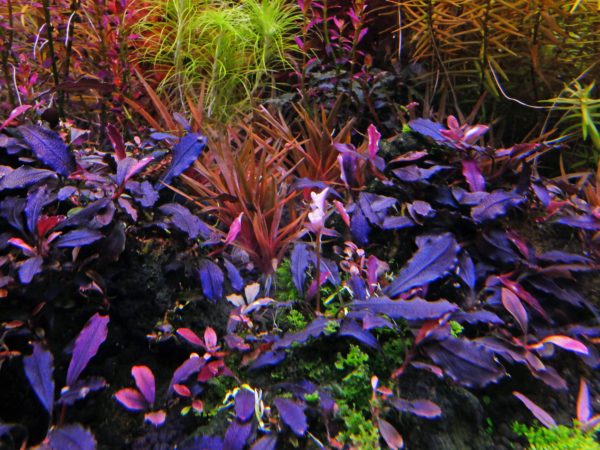
We said the bucephalandra is an easy plant to take care of, so let’s look at what they require to thrive in aquariums. It would benefit if you planted them with a hard substrate.
Consider adding rocks and larger tank liner substrates such as gravel into the aquarium. Their roots system is far-reaching, so they need larger and heavier additions to the tank to support themselves.
Contrary to people’s belief, the bucephalandra is not suitable for soil. They need a larger substrate to grasp and anchor themselves. They are the type of plants to meander their roots through crevices and holes, which means the more porous the rocks and driftwood are, the better.
They are generally a low-light plant, so there isn’t much they need if you have the bucephalandra in your tank for decorative purposes. Placing them in a low-light aquarium away from bright light will do. However, the lack of sufficient lighting will contribute to their slow growth.
If you want brighter coloration that accentuates the unique leaves and perhaps the flowers, placing them in medium to high light locations would accelerate their growth and coloring.
The bucephalandra only needs sufficient lighting to survive. If you want to grow bucephalandra quickly and in large bunches, you need to add CO2 or other nutrients to boost growth.
Make sure the water is well filtered and clear. The flow should be slow and steady to match its natural environment in Indonesia. It would benefit if you also kept your tank clean. There must not be a lot of algae buildup since the bucephalandra is very vulnerable to it.
You need to prune them, clean the tank regularly and switch out the water to rid it of any organic debris. The fish species sharing the aquarium with this plant need to be clean. By clean, we mean species that don’t make messes and leave leftovers in the tank.
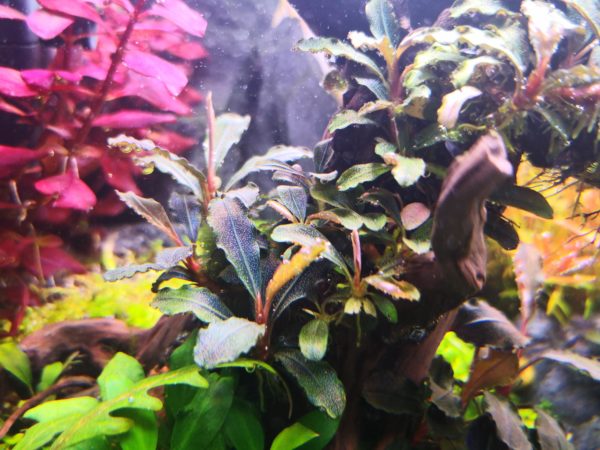
Cleaner fish and other algae-eating tank cleaners such as small crustaceans and snails can help maintain the tank for the bucephalandra.
Optimum Tank Size for Bucephalandra
The recommended tank size for bucephalandra is 5 gallons.
Tank Shape for Bucephalandra
A 10-gallon aquarium will support the growth of all species. However, the taller species will need more frequent pruning than the shorter ones due to their increased height. You may house smaller species in aquariums as little as 5 gallons in volume.
Filter Type
In an ideal situation, your filter output will generate a significant current. If this is not possible, consider utilizing an air/water pump.
Substrate
Because bucephalandra’s roots are so strong, you have a great choice in deciding on the substrate for your plant. Since it is pretty excellent in attaching and developing itself from the decorations in the tank, there is no need to utilize a substrate at all.
Water Parameters for Bucephalandra
Water Temperature
The ideal water temperature for bucephalandra is between 71 °F and 82.5 °F (21.5-28 °C).
Water Flow Rate
Bucephalandra grows best in tanks with high flow.
Ph Level
The perfect pH level for bucephalandra is between 6-and 7.5.
Water Hardness
5 GH
Bucephalandra: Tank Landscape
Worst Plants for Bucephalandra Tanks
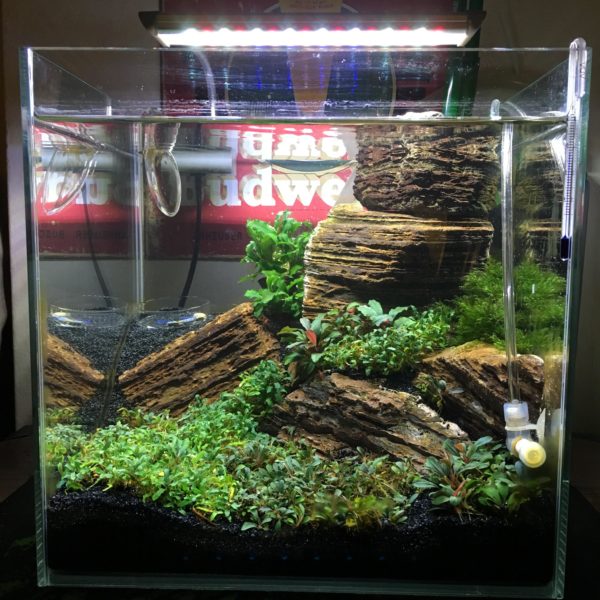
When combining bucephalandra with other plant species, competition for resources is crucial. It would be best to keep this bare minimum by separating them.
Decorations For Bucephalandra Tanks
Incorporating colored T5 tubes or a mix of RGBs and LEDs allow for the reflection of additional colors; nevertheless, you should use your judgment when selecting how much decoration to utilize; too much may seem artificial.
Lighting For Bucephalandra Tanks
Bucephalandra is a plant that does well in low light. Although they may be grown in nutrient- and CO2-rich water, utilizing low-lighting (50 moles of PAR) allows easy care. A considerable number of Bucephalandra are iridescent, which means that they are good at reflecting certain colors, mainly when seen from a specific camera angle.
For the most part, flat white T5 tubes and plain white LEDs do not provide a broad spectrum of light and do not allow colorful plants to show off to their best potential, mainly when used in combination.
Nutrient Requirements for Bucephalandra Tank?
If you do not wish to create vast clumps of bucephalandra in a short amount of time, you will not need to dose nutrients or CO2, just as you will not need to administer light. Although this plant enjoys CO2 and reacts well to nutrient dosing, if you have the opportunity to set up a system for it, you will almost get better results than you would
Planting Bucephalandra
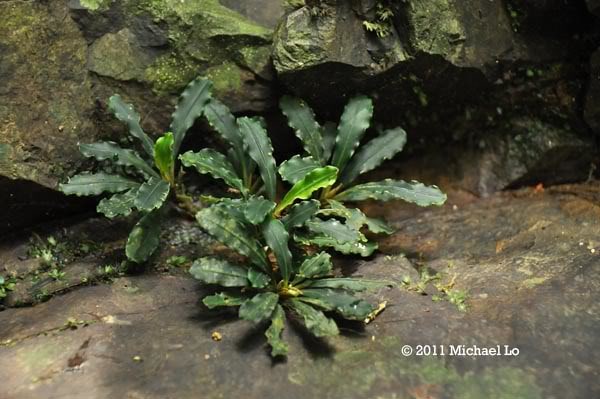
All you need to do is to attach the rhizomes to hard surfaces such as rocks or driftwood. You just need to make sure the roots are properly secured, then the plant will do the rest on its own. They growth rate is slow but they do show a few new leaves every week.
Due to them being a reophyte, the bucephalandra can be planted in aquariums, terrariums and even paludariums.
Propagation
Again, the bucephalandra is easy to care for. They grow along the rhizome without much help from you. You can trim the plantlets and place them on rocks or other parts of the hardscape and watch them reattach themselves and grow into new plants.
Bucephalandra Availability
They are relatively new plants to the aquarium trade but have quickly gained traction and increased their popularity over the past few years. They should be available in most stores depending on the species and type. There are many types of bucephalandra, and it’s amazing how they vary in price.
For example, the bucephalandra sp. Green Wavy is very cheap, but the Biblis Blue Sky can cost a lot more. If you find that your fish store lacks choices, the best place to purchase a new bucephalandra is actually from the Internet. Make sure you do your due diligence before you buy.
Bucephalandra: Compatibility and Tank Mates
Ideal Bucephalandra Tank Mates
- Dwarf Gourami
- Mollies
- Rosy Barbs
- Zebra Danios
- Neon Tetras
- Swordtails
- White Cloud Mountain Minnows
- Yoyo Loaches
- Chinese Algae Eaters
- Ghost Shrimp
- Amano Shrimp
- Cherry Shrimp
- Mystery Snails
- Nerite Snails
- Ramshorn Snails
Bucephalandra: Bad Tank Mates
Bucephalandra grows slowly, making it less able to recover from harm than other types of bacteria. Even little bites from fish will be difficult; some species (such as oscars) have a penchant for uprooting whole plants, making them much less recoverable.
Growing Bucephalandra
How do you grow bucephalandra? Much like other organisms on this planet, bucephalandras need adequate free space to grow. Depending on where your plants were sourced, they may arrive in large clumps. Many aquarists feel that separating these clumps into the individual plants will damage them. However, if you do separate them for planting in the aquarium or out, it will allow them to grow at a much faster pace.
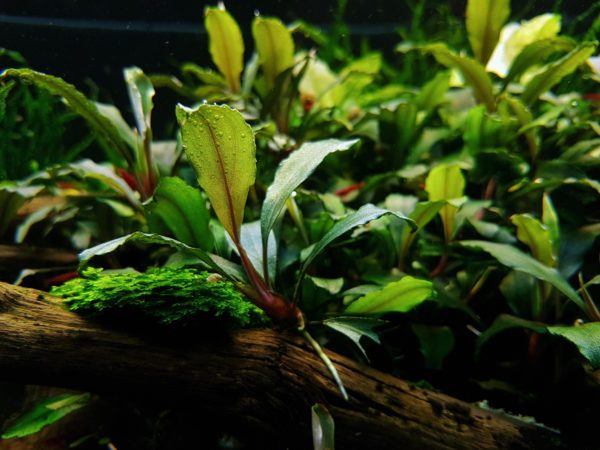
When you are separating them, make sure you prune the bucephalandra as well. You can identify the older dying leaves by the coloration. If they seem dull or are very faded, you can go ahead and cut them off. Clear off any of the debris and place the readied plants onto the rocks and wood surfaces then they will do the rest themselves.
There are some tips and tricks for faster growth. Fertilizing aquarium plants is a possibility with the right tools and adding CO2 is imperative to their growth as well. Adding CO2 via a CO2 compressor and make sure your tank is always maintained within the suggested pH levels (6.5-7).
The bucephalandra also requires macro and micronutrients just like we do. There are tons of aquatic plant fertilizers you can look into for your buce. As for the color, keep in mind that the lighting is key. Since they aren’t very sensitive to any sort of light, you can place them near windows (if your fish allow it) for them to grow faster and more beautifully. The color of the leaves doesn’t change depending on the species but the spots on the underside do.
Sometimes you will find red, white or yellow spots and these cute embellishments are a direct result of photosynthesis. So you can postulate that more light equals more color variations and brighter hues.
Problems with Bucephalandra Growth
They are easy to care for species, but there are still factors you need to pay attention to in the aquarium in order to achieve a high growth rate.
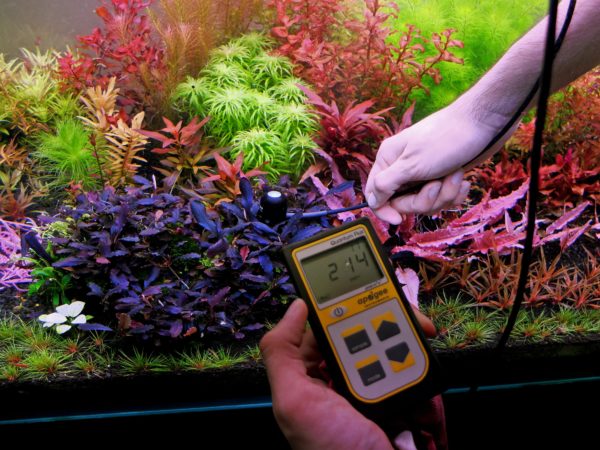
When you initially place an emersed plant into the aquarium, you may see some melting of the leaves as it gets accustomed to tank life. As long as the plant doesn’t rot, all you need to do is to remove those leaves and wait for your bucephalandra to regain balance in the water.
If you add a submersed bucephalandra to the aquarium, that still doesn’t guarantee there won’t be a transition period. Due to changes in the water, lighting, and surroundings, your bucephalandra might lose all its leaves. Although they are hardy, this species does not like changes and fluctuations in the water. Think of them shedding their leaves as some type of protest.
As long as you make sure there is nothing else wrong, such as rot, then chances are your bucephalandra will bounce back within a week or two.
If your bucephalandra is having growth issues, such as dull and washed out coloration or barely any growth, then you need to take a look at the lighting. The exotic coloration of red, blue, green, white, and so on is the reason why aquarists love this species so much. In order to help it reach its full potential, you may need to move it to an area with more light.
Even after your bucephalandras have become accustomed to the tank, there is still a chance they may shed their leaves again. You will see this if there are any noticeable changes in the water condition. Another thing is that although they are tough, they recover slower than other species when they are damaged.
The average recovery period for buces can range from several weeks to several months. Keeping them safe and healthy is the key to their prosperity.
Uses of Bucephalandra
The bucephalandra doesn’t possess any world-changing properties or capabilities, just their beauty. Because of their strong root system and their ability to “hang on” they have been a new addition to the tank that many aquarists can appreciate. They are mainly used to beautify your aquarium and hold the substrate together.
Bucephalandra Price
The bucephalandra is considered quite an expensive plant. This could be due to their exotic nature and origins and being fairly new to the aquarium world. We believe that over time when we learn more about these mysterious plants and their species, they will also become more affordable.
Facts About Bucephalandra
- Bucephalandra got its name after Alexander the Great’s superb black horse, Bucephalus, which means “beautiful black horse” in Greek.
- Despite being a hardy plant, Bucephalandra can withstand a broad range of water-related situations. On the other hand, hard water has a more significant detrimental effect on the bucephalandra plant than soft water.
- The plant’s flexibility and upkeep make it a popular choice for planted tanks, aquariums, terrariums, ponds, and lakes. A diverse range of plants generates flowers.
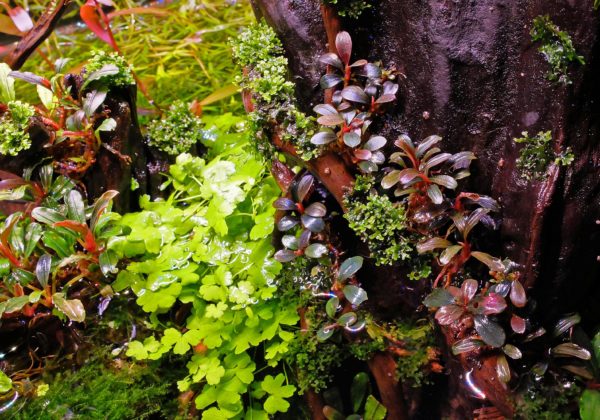
Is Bucephalandra Right for You?
For the most part, it’s understandable why bucephalandra is in such great demand as a freshwater aquarium species. The genus has many visually appealing plants that are also extremely easy to nurture. Because of the versatility shown by this plant, it is an excellent choice for use in the production of aquascapes in aquatic environments.
The fact that they are iridescent means that they are equally good at reflecting particular colors, which helps to improve the aesthetics of the aquarium. Once you put them in the tank, the only thing left to do is keep an eye on them to ensure that they are not getting sick. However, it would help if you were alert for signs of damage since they will be caring for themselves in the long term.
FAQs
What Is Bucephalandra’s Maximum Size?
These water plants can grow to a maximum size of 10 inches (25 cm), although this is rare considering their slow development rate.
Is Bucephalandra Able to Grow in Direct Sunlight?
Bucephalandra may be grown in your aquascape’s darker, darkened sections since it requires less light.
Is Bucephalandra Capable of Growing on Driftwood?
Bucephalandra is a slow-growing plant with long, thin rhizomes that take a long time to sprout new leaves. As seen in the photo, cutting the rhizome and adhering it to driftwood and rocks using super glue gel or thread is one way to cultivate it.
What Is the Most Effective Method for Growing Bucephalandra Tissue Culture?
As seen in the photo, cutting the rhizome and adhering it to driftwood and rocks using super glue gel or thread is one way to cultivate it.
Conclusion
If your aquarium doesn’t see much debris or algae buildup, the bucephalandra is a beautiful addition to the tank that can really brighten things up. Of course, since they are found in warmer waters, you need to keep that in mind when deciding if they suit your fish. They hand on tightly to hardscapes around the tank and may not go well with fish species that like to dig and burrow.
Their amazing colors and exotic appearance are what give them that air of mystery that aquarists love. What makes them wonderful is their ability to adapt to different environments as long as the water quality doesn’t fluctuate. Even growing new plants is as easy as removing them, placing them, and securing them in their new habitat. If you are lucky, the bucephalandra might even bloom their coveted pink and white flowers from time to time to create a wonderland in your tank.
They are slow-growing and can be expensive, but with the right amount of care and patience, the bucephalandra is worth every penny and every effort.
